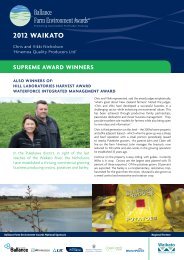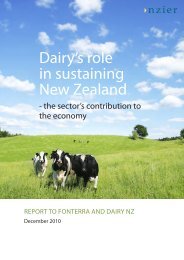Hearing Evidence – Brunner - Federated Farmers
Hearing Evidence – Brunner - Federated Farmers
Hearing Evidence – Brunner - Federated Farmers
You also want an ePaper? Increase the reach of your titles
YUMPU automatically turns print PDFs into web optimized ePapers that Google loves.
3.2 Policy 9.3.3 <strong>–</strong> To reduce the amount of phosphorous discharged in the Lake<br />
<strong>Brunner</strong> catchment.<br />
34. In further submissions, <strong>Federated</strong> <strong>Farmers</strong> supported the proposed change to the<br />
wording of this Policy by Fert Research to refine the focus of Policy 9.3.3 to<br />
phosphorous discharged to water, rather than phosphorous applied to land. It is good<br />
to see the staff report recommend this submission is accepted at Decision Requested:<br />
9.19. We also support the submission of Westland Milk Products as discussed at<br />
Decision Requested: 9.21 for the same reasons.<br />
3.3 Policy 9.3.4 <strong>–</strong> To require discharges of dairy effluent in the Lake <strong>Brunner</strong><br />
catchment to be to land rather than directly to water.<br />
35. In our submission, <strong>Federated</strong> <strong>Farmers</strong> asked that Council: Carefully consider the actual<br />
costs and benefits of the proposed objectives, polices, and rules. The importance of<br />
balancing costs and benefits is acknowledged at Decision Requested: 9.24.<br />
36. For example, effluent application systems are a technically complex area, and a variety<br />
of problems arise if rules and consents conditions are subject to prescriptive, rather<br />
than outcome-based criteria. Discussions with experts 3 suggest that the use of deferred<br />
irrigation of effluent (storage) is not feasible on the humped and hollowed and high<br />
rainfall land in the <strong>Brunner</strong> catchment. The pond calculator model for the West Coast<br />
predicts that optimum soil moisture conditions do not persist for long enough to get<br />
FDE onto land fast enough to keep ponds empty, and that it will be very difficult for<br />
farmers to maintain a useful irrigation buffer, even with very large ponds. Furthermore,<br />
Michael’s experience in Southland is that large storage ponds are prone to failure as<br />
clay liners erode and crack, or as synthetic liners are compromised by rising methane<br />
gas from decomposing soil organic matter. Unsuitable design can also lead to severe<br />
problems with odour. Thus, any storage pond must be suitable for the climatic<br />
conditions and designed and constructed to a very high engineering standard,<br />
otherwise a structure intended to achieve certainty and reduced contaminant loss from<br />
the farm system will have the opposite effect, with wasted capital, on-going worry for<br />
farmers, and lack of certainty for the Council the likely result.<br />
37. With effluent systems, <strong>Federated</strong> <strong>Farmers</strong> prefers simple systems that achieve certainty<br />
of outcome, and that come at reasonable cost so as to leave farmers with resources to<br />
address other areas of environmental performance. Rushing through with prescriptive<br />
solutions, even as researchers are working to develop effluent systems suitable for<br />
high rainfall environments, is likely to lead to high cost and poor environmental<br />
performance in the long term.<br />
3 Dr Dave Houlbrooke pers comm 9-01-2012<br />
8
















